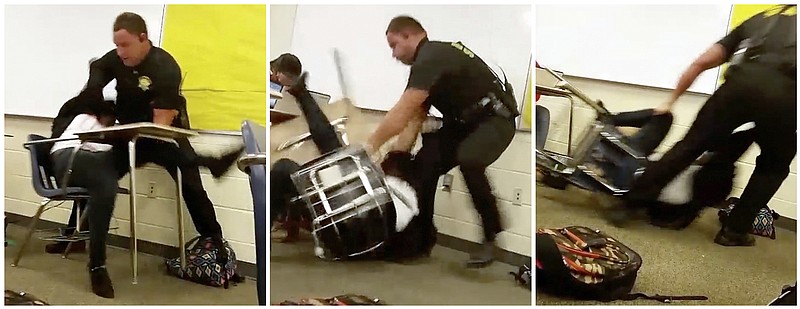Over the last year, we've seen plenty of police action that should give our nation pause.
But student videos of a school resource officer in Columbia, S.C., may be what finally crystallizes the meaning of all these "oh, no, not again" videos we've seen in recent years - and the aftermaths that follow.
As a nation, and community-by-community, we must insist on police protection, not a police state.
First, a stipulation: Almost all police are good people with good - no, wonderful - intentions. They have an incredibly hard job - be an enforcer, a psychologist, a social worker and a mentor, often all on the same help call, whether it be to a school, a home, a business, a halfway house or a bank robbery.
But the training officers receive - especially in the psychologist, social worker and mentor departments - clearly leaves something to be desired.
Lest anyone think incidents like those we've seen on the national stage don't happen here, think again.
In 1993, two officers pulled over 39-year-old Larry Powell near Soddy-Daisy on suspicion of drunk driving. The officers said Powell, a former heavyweight boxer, resisted when told he was being arrested. Five officers handcuffed Powell, who was black, put him face down on the ground and used a chokehold. An autopsy blamed Powell's death on the chokehold. There was no video, but there was a witness - a passenger in Powell's car. A local grand jury exonerated the officers.
On June 14, 2012, the security cameras for a local Salvation Army halfway house for federal offenders on house arrest showed two Chattanooga officers take down 37-year-old Adam Tatum. A white officer tells Tatum, who is black, to put his hands behind his head. Almost immediately, the officer places Tatum in a chokehold, spins him around and throws him to the ground. That officer and a second one continue for at least seven agonizing minutes to slam their batons onto Tatum and scream at him to roll over. All Tatum is able to do is try to cover his head and body from the blows. By the time Tatum is handcuffed he has been struck dozens of times and suffered six fractures to his right leg and two fractures to his left leg, including a compound break. A Hamilton County grand jury declined to indict the two officers, who are no longer with the police department.
Our schools aren't exempt from suspect police behavior, either. Without student video, only a handful of people would have known about the LaFayette High School resource officer who turned his Taser on two girls in a rolling cat-fight in the school yard. The girls were charged with a misdemeanor. The resource officer was promoted.
None of our cases received national attention. But the notoriety of other cases around the country has contributed to what law enforcement officials now dub "the Ferguson effect." FBI Director James Comey made an issue of it recently.
"In today's YouTube world, are officers reluctant to get out of their cars and do the work that controls violent crime? Are officers answering 911 calls but avoiding the informal contact that keeps bad guys from standing around, especially with guns?" he asked. "I don't know whether this explains it entirely, but I do have a strong sense that some part of the explanation is a chill wind blowing through American law enforcement over the last year. And that wind is surely changing behavior."
Comey also said "far more people are being killed in America's cities this year than in many years," but he later acknowledged to reporters that he could not prove his assertion with numbers.
In fact, violent crime remains at historic lows. CNN reported in recent days that even in cities where dozens of shootings in a weekend regularly make national headlines, violent crime rates were far higher 20 years ago. Chicago has recorded more than 400 murders this year, but that's well short of the 900-plus common in the early 1990s. Washington, D.C., recorded 124 killings this year, up from 88 last year but far lower than the 400 in 1996.
Chattanooga fits this category, too, despite the concerns and a new emphasis on gang-related shootings. Since 2011, our yearly homicide numbers have been 25, 24, 19, 27, and 24. This year's 24 includes five U.S. servicemen all killed in one day by a homegrown "extremist."
President Barack Obama warned against cherry picking data or using anecdotal evidence, and he pushed back against Comey's "chill wind" comment: "I reject any narrative that seeks to divide police and communities they serve; that frames any discussion of public safety around 'us' and 'them.'"
White House press secretary Josh Earnest said there was no evidence that police officers were "shirking" their duties given increased scrutiny.
Still, there may be an unfortunate "Ferguson effect." One perhaps better dubbed "South-Carolina-teenage-girl-slammed-down-then-thrown-across-the-room effect."
The public may no longer feel that warm police respect once afforded to officers - the kind of respect captured by iconic American artist Norman Rockwell when he painted a state trooper sitting at a lunch counter with a little boy whose favorite belongings are tied to a stick with a red kerchief. The painting is titled "The Runaway," and it is a direct reference to old-time community policing.
We're glad the late Rockwell didn't have to see the South Carolina classroom video.
